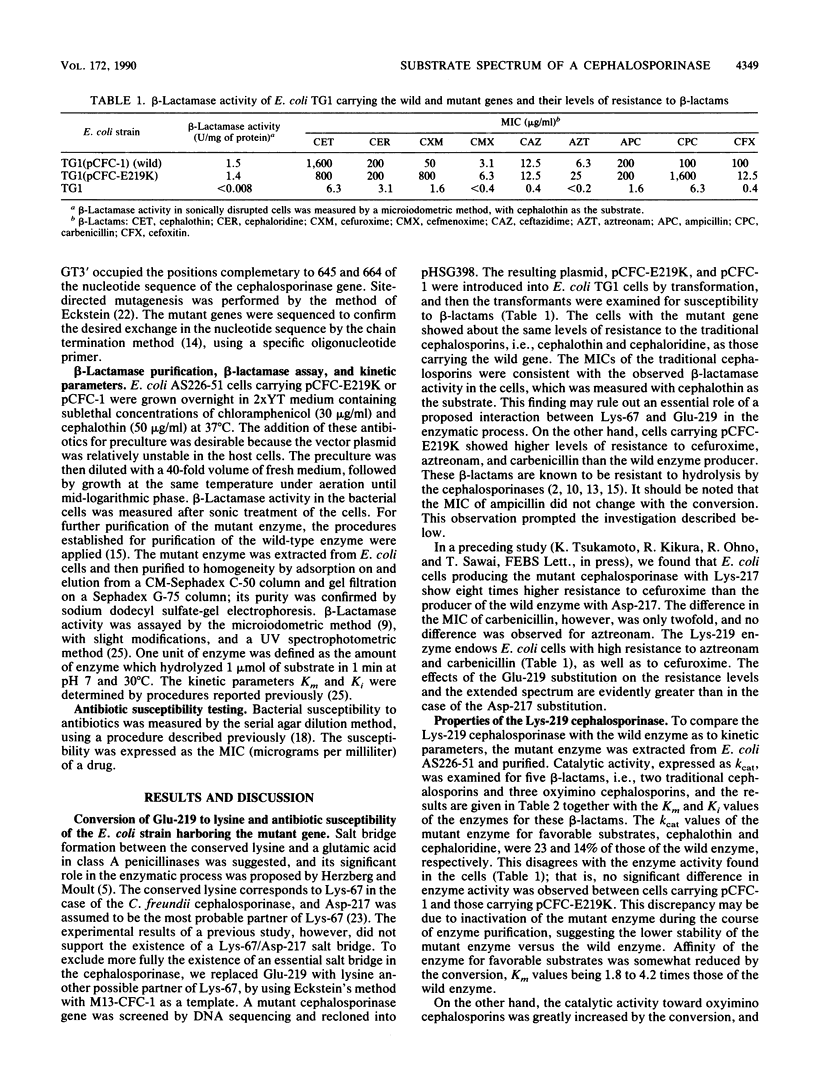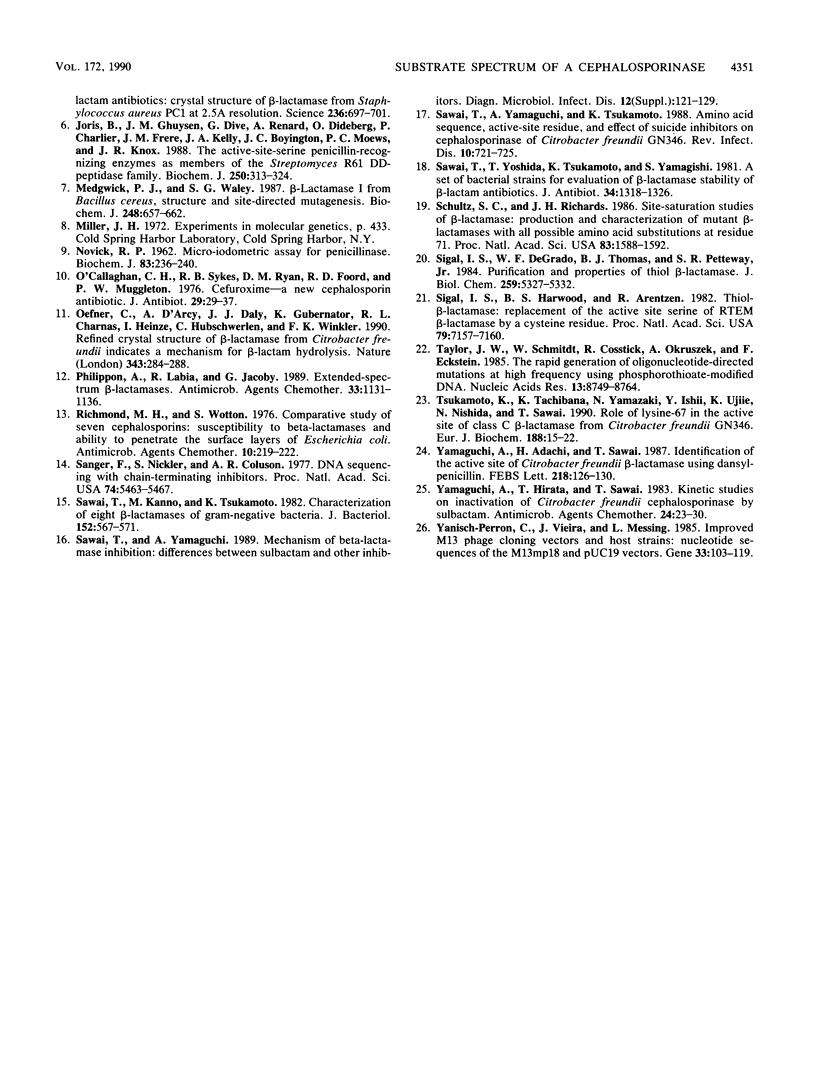Abstract
The cephalosporinase of Citrobacter freundii GN346 is a class C beta-lactamase, consisting of 361 amino acids and exhibiting the substrate profile of a typical cephalosporinase. On the conversion of a conserved glutamic acid at residue 219 to lysine, the substrate spectrum of the cephalosporinase was extended to oxyimino cephalosporins, aztreonam and carbenicillin, which are essentially undesirable substrates for the enzyme. Escherichia coli cells carrying the mutant gene showed higher resistance levels to cefuroxime, aztreonam, and carbenicillin, but a lower resistance level to cefoxitin, than cells carrying the wild gene. The kcat values of the purified mutant enzyme for ceftazidime, cefuroxime, and cefmenoxime were 77,100, and 300 times those of the wild enzyme, respectively. The relative Vmax values of the mutant enzyme for aztreonam and carbenicillin were determined to be 11 and 23 times those of the wild enzyme, respectively, but the value of the mutant enzyme for cefoxitin was only one-third that of the wild enzyme.
Full text
PDF



Selected References
These references are in PubMed. This may not be the complete list of references from this article.
- Ambler R. P. The structure of beta-lactamases. Philos Trans R Soc Lond B Biol Sci. 1980 May 16;289(1036):321–331. doi: 10.1098/rstb.1980.0049. [DOI] [PubMed] [Google Scholar]
- Dalbadie-McFarland G., Cohen L. W., Riggs A. D., Morin C., Itakura K., Richards J. H. Oligonucleotide-directed mutagenesis as a general and powerful method for studies of protein function. Proc Natl Acad Sci U S A. 1982 Nov;79(21):6409–6413. doi: 10.1073/pnas.79.21.6409. [DOI] [PMC free article] [PubMed] [Google Scholar]
- Herzberg O., Moult J. Bacterial resistance to beta-lactam antibiotics: crystal structure of beta-lactamase from Staphylococcus aureus PC1 at 2.5 A resolution. Science. 1987 May 8;236(4802):694–701. doi: 10.1126/science.3107125. [DOI] [PubMed] [Google Scholar]
- Joris B., Ghuysen J. M., Dive G., Renard A., Dideberg O., Charlier P., Frère J. M., Kelly J. A., Boyington J. C., Moews P. C. The active-site-serine penicillin-recognizing enzymes as members of the Streptomyces R61 DD-peptidase family. Biochem J. 1988 Mar 1;250(2):313–324. doi: 10.1042/bj2500313. [DOI] [PMC free article] [PubMed] [Google Scholar]
- Madgwick P. J., Waley S. G. beta-lactamase I from Bacillus cereus. Structure and site-directed mutagenesis. Biochem J. 1987 Dec 15;248(3):657–662. doi: 10.1042/bj2480657. [DOI] [PMC free article] [PubMed] [Google Scholar]
- NOVICK R. P. Micro-iodometric assay for penicillinase. Biochem J. 1962 May;83:236–240. doi: 10.1042/bj0830236. [DOI] [PMC free article] [PubMed] [Google Scholar]
- O'Callaghan C. H., Sykes R. B., Ryan D. M., Foord R. D., Muggleton P. W. Cefuroxime - a new cephalosporin antibiotic. J Antibiot (Tokyo) 1976 Jan;29(1):29–37. doi: 10.7164/antibiotics.29.29. [DOI] [PubMed] [Google Scholar]
- Oefner C., D'Arcy A., Daly J. J., Gubernator K., Charnas R. L., Heinze I., Hubschwerlen C., Winkler F. K. Refined crystal structure of beta-lactamase from Citrobacter freundii indicates a mechanism for beta-lactam hydrolysis. Nature. 1990 Jan 18;343(6255):284–288. doi: 10.1038/343284a0. [DOI] [PubMed] [Google Scholar]
- Philippon A., Labia R., Jacoby G. Extended-spectrum beta-lactamases. Antimicrob Agents Chemother. 1989 Aug;33(8):1131–1136. doi: 10.1128/aac.33.8.1131. [DOI] [PMC free article] [PubMed] [Google Scholar]
- Richmond M. H., Wotton S. Comparative study of seven cephalosporins: susceptibility to beta-lactamases and ability to penetrate the surface layers of Escherichia coli. Antimicrob Agents Chemother. 1976 Aug;10(2):219–222. doi: 10.1128/aac.10.2.219. [DOI] [PMC free article] [PubMed] [Google Scholar]
- Sanger F., Nicklen S., Coulson A. R. DNA sequencing with chain-terminating inhibitors. Proc Natl Acad Sci U S A. 1977 Dec;74(12):5463–5467. doi: 10.1073/pnas.74.12.5463. [DOI] [PMC free article] [PubMed] [Google Scholar]
- Sawai T., Kanno M., Tsukamoto K. Characterization of eight beta-lactamases of Gram-negative bacteria. J Bacteriol. 1982 Nov;152(2):567–571. doi: 10.1128/jb.152.2.567-571.1982. [DOI] [PMC free article] [PubMed] [Google Scholar]
- Sawai T., Yamaguchi A., Tsukamoto K. Amino acid sequence, active-site residue, and effect of suicide inhibitors on cephalosporinase of Citrobacter freundii GN346. Rev Infect Dis. 1988 Jul-Aug;10(4):721–725. doi: 10.1093/clinids/10.4.721. [DOI] [PubMed] [Google Scholar]
- Sawai T., Yoshida T., Tsukamoto K., Yamagishi S. A set of bacterial strains for evaluation of beta-lactamase-stability of beta-lactam antibiotics. J Antibiot (Tokyo) 1981 Oct;34(10):1318–1326. doi: 10.7164/antibiotics.34.1318. [DOI] [PubMed] [Google Scholar]
- Schultz S. C., Richards J. H. Site-saturation studies of beta-lactamase: production and characterization of mutant beta-lactamases with all possible amino acid substitutions at residue 71. Proc Natl Acad Sci U S A. 1986 Mar;83(6):1588–1592. doi: 10.1073/pnas.83.6.1588. [DOI] [PMC free article] [PubMed] [Google Scholar]
- Sigal I. S., DeGrado W. F., Thomas B. J., Petteway S. R., Jr Purification and properties of thiol beta-lactamase. A mutant of pBR322 beta-lactamase in which the active site serine has been replaced with cysteine. J Biol Chem. 1984 Apr 25;259(8):5327–5332. [PubMed] [Google Scholar]
- Sigal I. S., Harwood B. G., Arentzen R. Thiol-beta-lactamase: replacement of the active-site serine of RTEM beta-lactamase by a cysteine residue. Proc Natl Acad Sci U S A. 1982 Dec;79(23):7157–7160. doi: 10.1073/pnas.79.23.7157. [DOI] [PMC free article] [PubMed] [Google Scholar]
- Taylor J. W., Schmidt W., Cosstick R., Okruszek A., Eckstein F. The use of phosphorothioate-modified DNA in restriction enzyme reactions to prepare nicked DNA. Nucleic Acids Res. 1985 Dec 20;13(24):8749–8764. doi: 10.1093/nar/13.24.8749. [DOI] [PMC free article] [PubMed] [Google Scholar]
- Tsukamoto K., Tachibana K., Yamazaki N., Ishii Y., Ujiie K., Nishida N., Sawai T. Role of lysine-67 in the active site of class C beta-lactamase from Citrobacter freundii GN346. Eur J Biochem. 1990 Feb 22;188(1):15–22. doi: 10.1111/j.1432-1033.1990.tb15365.x. [DOI] [PubMed] [Google Scholar]
- Yamaguchi A., Adachi H., Sawai T. Identification of the active site of Citrobacter freundii beta-lactamase using dansyl-penicillin. FEBS Lett. 1987 Jun 22;218(1):126–130. doi: 10.1016/0014-5793(87)81031-1. [DOI] [PubMed] [Google Scholar]
- Yamaguchi A., Hirata T., Sawai T. Kinetic studies on inactivation of Citrobacter freundii cephalosporinase by sulbactam. Antimicrob Agents Chemother. 1983 Jul;24(1):23–30. doi: 10.1128/aac.24.1.23. [DOI] [PMC free article] [PubMed] [Google Scholar]
- Yanisch-Perron C., Vieira J., Messing J. Improved M13 phage cloning vectors and host strains: nucleotide sequences of the M13mp18 and pUC19 vectors. Gene. 1985;33(1):103–119. doi: 10.1016/0378-1119(85)90120-9. [DOI] [PubMed] [Google Scholar]


